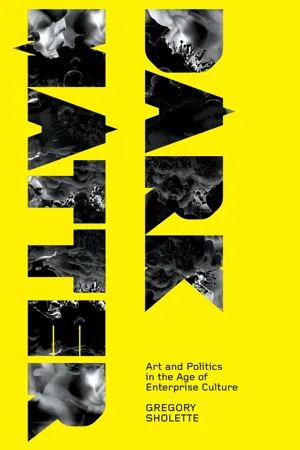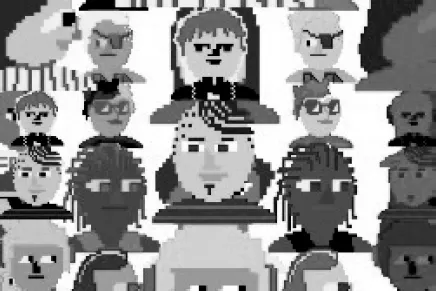![]()
1
ART, POLITICS, DARK MATTER: NINE PROLOGUES
Throughout history, living labor has, along with the surplus value extracted from it, carried on its own production—within fantasy.
Oskar Negt and Alexander Kluge1
Swampwall
For more than 30 years a close relation of mine has worked in the shipping and receiving department of a non-unionized factory in Northeast Pennsylvania. Early on in his employment he and several of his co-workers spent their work breaks attaching newspaper clippings, snapshots, spent soda cans, industrial debris, trashed food containers and similar bits and pieces of day-to-day detritus to one wall of the plant. After a few years this accumulated clutter covered most of the wall. The workers christened their impromptu collage the Swampwall. The owner of the factory, an aging sole-proprietor in a world of mergers and multinationals, long tolerated this workplace diversion until a global corporation bought out his company. A structural adjustment followed. Dozens of “redundant” employees lost their jobs. The manufacturing division of the factory was downsized, services emphasized, and post-Fordist systems of inventory and just-in-time outsourcing implemented. Needless to say, Swampwall was expunged. And though its makers remained employed they were tasked with higher productivity as their pensions, sick pay, health care, and other benefits were reduced through privatization. What was Swampwall? Notwithstanding the recent popularity of de-skilled slack art and “clutterfuck”—slap-dash cartoons pinned randomly to gallery walls; clumps of ephemera or manufactured goods spread haphazardly over museum floors; recycled cardboard and cheap packing-tape sculpture, or paintings made to appear the work of an amateur or Sunday painter—Swampwall was not art. Just compare my description of Swampwall to the way the contemporary American artist Tony Feher reputedly transforms “humble, ‘forgettable’ materials that he finds—bottles, jars, plastic soda crates … into work that is rich with human emotion and fragile beauty.”2 None of the factory workers ever attended college; none had likely ever visited an art museum. Their collaborative frieze was only visible to those with business in that particular wing of the plant; an uninviting, sweat-soaked warehouse filled with forklifts, loading pallets, and packing crates far from the tidy cubicles and product showrooms of upper management. As a haphazard archive of the everyday, Swampwall most closely resembled a spontaneous memorial to dead time. However, insofar as these workers made manifest a desire to direct some portion of their energy elsewhere, just as they pleased, Swampwall also represented a fantasy of autonomy. Not just any fantasy, not fantasy as illusion or self-delusion, but instead as Kluge and Negt point out, fantasy in the form of production, or, as Miriam Hansen succinctly puts it, “imaginative strategies grounded in the experience of production—protest energies, psychic balancing acts, a penchant for personalization, individual and collective fantasy, and creative re-appropriations.”3
Picasso’s monumental Guernica momentarily shifts from aesthetic object to activist intervention as the painting’s anti-war imagery is re-imagined as a jigsaw puzzle of picket signs carried aloft by a flock of art students protesting the concealment of a tapestry of the iconic artwork behind blue drapes during Colin Powell’s infamous UN speech leading up to the war in Iraq. This image was taken during the unprecedented global protest against US military action in February of 2003. Image courtesy Gregory Sholette.
PAD/D
On February 24, 1980, several dozen artists, activists, and future DIY (Do It Yourself) archivists gathered at a bookstore in downtown Manhattan. They came in response to a call for volunteers circulated by art critic Lucy R. Lippard who sought assistance in organizing an archive of documentation about the many good, socially active artists that no one had heard of.4 In the room were members of the recently formed art collective Group Material, as well as members of existing organizations such as Heresies, but also defunct groups including Art Workers’ Coalition (AWC), and Artists Meeting for Cultural Change. At least one participant had been active in the 1940s with the “old” American Left.5 There were also constituents of collectives yet to come, including the feminist-oriented cultural groups Carnival Knowledge and the Guerrilla Girls. An entire new organization was established that evening, whose ambitions, contrary to Lippard’s initial intentions, went far beyond the humble task of archiving. Within a year Political Art Documentation/Distribution (PAD/D) was publishing a newsletter, programming public events, networking with other politically active cultural organizations, and producing art for street demonstrations and street projects like Death and Taxes where artists created decentralized interventions in public spaces around New York City to protest government military spending just before April 14, “income tax day.” The new group opposed both the commercial and the not-for-profit art world, asserting contrarily that PAD/D “cannot serve as a means of advancement within the art world structure of museums and galleries. Rather, we have to develop new forms of distribution economy as well as art.”6 In order to realize this goal PAD/D sought to link a variety of exhibition spaces with activist, labor, and local community organizations, thus producing an entirely separate, left-wing sphere of culture. Populating this networked alternative art world would be those many unknown artists whose work was too political or socially involved for mainstream museums and galleries in the 1980s. For despite a substantial wave of politicized cultural experimentation that took place throughout the post-war period from the 1950s on up to the 1980s the mainstream art world remained strongly committed to abstract and formalist art, often defined by critics like Clement Greenberg and Michael Fried, or by a minimalist art that was indistinguishable from such formalism.7 PAD/D’s imagined parallel art world was not unlike the cultural organizations of the 1920s and 1930s organized by labor unions, socialists, and the Communist Party USA, except in the 1980s there was little counter-institutional power to provide support. Its stated aim was to build “an international, grass roots network of artist/activists who will support with their talents and their political energies the liberation and self-determination of all disenfranchised peoples.”8 This romantic, anti-imperialist rhetoric energized the group for a while, but neither the historical circumstances nor the technology of the early 1980s permitted PAD/D to realize its somewhat grandiose counter-institutional mission. Furthermore, the actual day-to-day tasks of organizing meetings, networking, publishing and mailing newsletters, and collecting, dating and storing archival materials took its toll on the group. Eight years after its founding PAD/D ceased meeting. Though the Archive Committee continued, the programs and activist street art ended. In a solemn editorial farewell in PAD/D’s newsletter Upfront, the group recognized that its demise coincided with a prudent form of “political art” becoming briefly fashionable in the art world.9 Nor was it entirely a coincidence that the organization’s demise coincided with this appropriation of counter-culture by the mainstream art world and the consolidation of a decade-old rightward political shift in the US, UK, Canada, and elsewhere. PAD/D’s attempt to establish autonomy from mainstream art culture ended, paradoxically, with the incorporation of its Archive into the Library of the Museum of Modern Art (MoMA), New York City, where its 50-plus linear feet of flyers, memos, news-clippings, posters, slides, and other forms of documentation now reside: something of an anti-formalist trove encrypted within what is perhaps the foundational institution of high modernist formalism. Nevertheless, the frequently ragged and fading contents of this other, surplus archive remain, still, almost entirely unheard of, as if forming a hole or zone of dark matter in the very heart of the formal art world’s circulatory system.10
Paper Rad
MoMA and the gatekeeper galleries of the art world are far from Pittsburgh Pennsylvania where three artists collectively known as Paper Rad share studio space. Founded twelve years after PAD/D’s demise, Paper Rad’s DIY aesthetic incorporates electronic music (both recorded and performed live), knitted sculptures, and comic-book-like publications filled with day-glo doodles and cartoon characters.11 But the group is probably best known for its heavily pixilated video animations that look like “claymations” or “puppetoons” made under the influence of psilocybin. Brash, youthful, and disarmingly flippant, Paper Rad is one of many insouciant and often-short-lived artists’ collectives that have appeared over the past decade. Groupettes such as Gelitin, Bathus International, Reena Spaulings, Derraindrop, hobbypopMUSEUM, Beige Programming Ensemble, Forcefield, and Paper Rad mix visual art, fashion, and music in an ambient form of collectivism that has the same relation to previous forms of cultural mobilization (i.e. PAD/D, AWC, Group Material), as social networks such as Facebook or Twitter have to organized politics. In contrast to PAD/D’s relative invisibility during the 1980s, the contemporary art world of the early twenty-first century has come to embrace this “whatever” mode of collectivism. Tate Britain, Deitch Projects, the Whitney and Liverpool Biennials are among the high-profile institutions that have featured Paper Rad’s neo-Pop art installations, performances, and video screenings, and yet the group itself claims to be most “at home” in the vertiginous arena of cyberspace. “The Internet represents a new form of chaos in which you experience all these different source materials jumbled together,” insists one Paper Rad member, her sentiments echoed by the group’s full-service website: a pulsating, polychromatic light-show crammed with free downloadable cartoons, memorabilia, noise music, poetry, documentation of artworks, and a series of e-mailable “get-well” postcards that, when downloaded, purportedly contain a virus capable of infecting your computer with “love.”12 Cyborg-like and spectacularly digitized, this technologically enhanced collectivism appears to have no proprietary boundaries; its communal commingling being identical with the networks that give rise to it. Nonetheless, some of these new, politically indeterminate artist’s groups have commercial dealers who face particular difficulties trying to sell their multi-authored work. It seems collectors seek secure, long-term investments, whereas group identity is inherently unstable. One New York City art dealer devised his own solution to this problem: organize solo exhibitions for each member of Paper Rad, reassuring anxious collectors that behind the group’s communal persona lie three distinct talents.13
Paper Rad, “P-Unit Mixtape,” 2005. An image grab from one of the delirious video projects created by the Pittsburg-based collective Paper Rad that synthesizes found materials from television, video games, and advertising sources in combination with digitally produced, zine-like imagery. The 21:08 minute music video is filled with day-glo cartoon characters, talking animals, and oblique references to the war in Iraq. It is viewable on YouTube at: http://vodpod.com/watch/971081-paper-rads-p-unit-mixtape-2005. Image courtesy Electronic Arts Intermix (EAI), New York.
Battles have even erupted over the organizational property of disbanded collectives and former members have disputed who has rights to the group’s moniker. The Danish artists’ group N55 now has only one original member, and the Guerrilla Girls split into several groups in 2000 with one iteration involved in performing as the Guerrilla Girls. Needless to say, such asset management seems antithetical to the free-wheeling, communal identity Paper Rad represents on their website:
If you are trying to write an article, a school paper, or telling your mom or dad, or boss, basically you are screwed, you can say words like 3 member art collective, but remember that you are lying and are just trying to translate what we are trying to do into america-speak again … if you are a art collector, policeman, or ad agency, we are no company, its individuals making things, you like the name Paper Rad? great, you don’t like it, even better, run with it, ask me who i am, maybe i’ll tell you [sic].14
The group’s taunting identity games and refusal to be translated into “america-speak” come off as magic incantations for warding off commercial branding. And yet, this is precisely the fate that has already overtaken them. Perhaps the clearest evidence of this fall from grace is the group’s response to the publication “BJ & the Dogs 2,” a zine-like booklet that appeared on several websites in 2006 with all the earmarks of Paper Rad’s comic-book aesthetic. Once freely downloadable, as well as available for purchase as a hard copy, the ersatz booklet was nonetheless a counterfeit pseudonymously authored by the “Paper Rad Liberation Front.” Soon after it appeared online, Paper Rad’s attorney responded with a Cease and Desist letter posted on the group’s blog. It called the imposters identity thieves who had stolen the authentic trio’s “copyrighted images, likeness, and names.” Paper Rad’s website subsequently assured fans “we are and always have been and always will be ‘real’ Paper Rad (‘real’-- weird).”15 But the beguiling ambivalence about collective forms of identity once so playfully expressed are now brought up short by the return of the real “real,” the concrete demands of the contemporary marketplace.16
Surpluses
Workers “expressively” killing time in a factory; an archive about unknown artists gathered and organized by other, unknown artists; giddy hallucinations of a distributed collectivism colliding with everyday economic realities—no matter how often such impulses towards autonomy meet with defeat one thing is clear: capitalism and its disciplinary routines continue to be haunted by what it has promised and has repeatedly failed to deliver, namely, a life free from the bridle of scarcity and the monotony of mundane labor, while rich in human solidarity and sensual, aesthetic expressivity. Sometimes the desire flashes up for an instant, bursting forth with symbolic ferocity amongst disgruntled workers, radicalized students, women and minorities structurally marginalized or totally cut off from the system’s daydream. On rare occasions it materializes as direct action, swiftly deforming existing aesthetic, political, and institutional regimes. When not suppressed by legal mechanisms that regulate so-called intellectual property or state security (and increasingly these two have merged into one), it is confronted with phalanxes of riot police who meet this overflow of anticipation with tear gas, rubber bullets, crowd nets, and improvised holding cells. Which is why this spectral expectancy is more often like a low-grade fever, smoldering wherever individual lives are no longer mediated by collective or governmental protections, wherever local conditions of life and work, time and space have been dismantled by the spread of ultra “free market” ideologies (although clearly the new capitalist world crisis is testing the limits of this narrative, which suddenly seems to be fighting for its ideological life). The most recent global financial collapse has only served to underscore this ruined landscape between promises and everyday life. All at once 30 years of consumer-driven, unregulated “growth” suddenly contracts to reveal what even many on the Left had tried to forget. As Slavoj Žižek recently opined, borrowing his words in part from Clinton’s 1992 US presidential election: it’s the political economy stupid! But his aim is not to return us to an outmoded theory of Marxist base and superstructure in which the maintenance of ideology is strictly determined by the relative health of capitalist markets. It is instead a way of reading history. “When the normal run of things is traumatically interrupted, the field is open for a ‘discursive’ ideological competition.”17 Žižek points out that it was Hitler, rather than social democrats or communists who won in the competition for a narrative that would explain the German economic collapse and military defeat after World War I. The question now is what narrative will come out on top today?
This long drawn out historical dreaming might well have remained just what it has always been—a patchy counter-history, marked by muted anticipations, repetitions, and defeats—and yet something has happened to alter this narrative that sometimes resembles a low-budget movie which appeals to us despite faulty dialogue, non-linear editing, and awkward dues ex machina. The desire for collective, cultural autonomy has become tantalizingly conspicuous of late, as has the sheer overabundance of activity, ideas, imaginative practices, and everyday creativity generated by what increasingly appears to be a massive surplus population that capital is not sure what to do with, especially when that collective body is too frightened even to over-consume. It is as if a previously overlooked mass of excess social productivity has suddenly been forced into view, as if a once-shadowed archive has spilt open. This other productivity (inventive also though intentional non-productivity) is materializing in places both familiar and unexpected, from the shantytowns of the imagination, to the depths of corporate, governmental, and institutional structures. It is fundamentally altering the formal artistic culture, or what is often simply called “art.” It is also transforming the nature of the popular spectacle that dominates global society and all that remains of the public sphere. One can hardly escape an encounter with this vast and heterogeneous bounty of imaginative activity today as it radiates from homes, offices, schools, streets, community centers, artistic venues, and in cyberspace, especially in cyberspace, which uniquely marks the point of contact between the dark, surplus archive and the everyday. And it harbors its own forms of community and collectivism that are simultaneously new and archaic. So far this decentralized fraternization can only be represented by the jumbled p...


